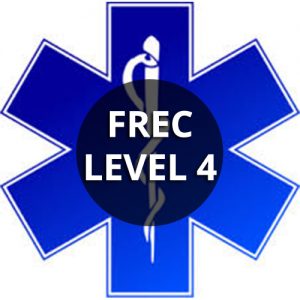FREC LEVEL 4
Pre-requisite of FREC® Level 3Fulfilling the competencies set out in the Pre-Hospital Emergency Medicine (PHEM) skills framework at descriptor level E, this qualification provides learners with the knowledge, skills and competencies needed to be able to deal with a wide range of Prehospital care emergencies, such as: major incidents, fracture immobilisation, sick and injured children, mental health issues and more.
Anyone wishing to enrol on this course must hold a current and in date FREC 3 qualification.
ABCDE APPROACH TO CONDUCTING AN INITIAL PATIENT ASSESSMENT
- Homeostasis/physiological variables including; Blood glucose levels; Blood & issue oxygen and carbon dioxide levels; Blood pressure; Core temperature; Water and electrolyte concentrations; Ph level of body fluids
- Normal physiological values including; Breathing rate; Capillary refill; Heart rate; Blood pressure; Temperature; Blood glucose level; Oxygen saturations
- Negative and positive feedback mechanism including; Presenting complaint/History of presenting complaint; Past medical history; Drug/medication history; Overall impressions; SOCRATES pain scoring; Wong-Baker FACES pain rating scale; FLACC scale; Glasgow Coma Scale; FAST test; Physiological measurements; use of sphygmomanometer and stethoscope; use of thermometer; use of pen torch; Blood glucose meter; Peak flow meter; Pulse oximeter; Peak expiratory flow rate; Capnography; Heart and cardiovascular emergencies; Atheromatous plaque; Pathological changes associated with heart disease
- Structure/Function of the heart including; Pericardium; Myocardium; Endocardium; Blood supply; Cardiac conduction system; Sinoatrial node; Atrioventricular node; Autonomic nervous system; Stages of the cardiac cycle.
- Coronary artery disease including; Heart failure; Arrhythmias; Blood vessel pathological changes: Atheromatous plaques; Causes of atheroma; Effects of atheroma; Predisposing factor in atherosclerosis; Arteriosclerosis; Thrombosis; Infarction; Haemorrhage; Aneurysm
- ECG use including; Electrical changes of the heart (P, Q, R, S, T waves); Difference between 3 and 12 lead ECG trace; Cardiac output; Stroke volume; 3-lead ECG; Normal sinus rhythm; Ventricular fibrillation; Ventricular tachycardia; Asystole; Pulseless electrical activity; Bradycardia; Tachycardia; First degree atrioventricular heart block; Second degree atrioventricular heart block type 1 (Wenckebach); Second degree atrioventricular heart block type 2 (Mobitz); Third degree atrioventricular heart block (complete); ECG paper components; Calibration; 12-lead ECG including; Premature ventricular contractions (PVC); Accessory pathways; ST elevation/depression; SVT’s including supraventricular tachycardia; atrial fibrillation and atrial flutter
- Invasive skills assists including; Canulation and bag fluids preparation; Intra muscular injection (IM); Subcutaneous injection (sub-cut); Supraglottic airways including; I-Gels; Laryngeal Mask Airways (LMA’s); Intraosseous access bone drilling/puncturing; Endotracheal (ETT) tube intubation; Magill forceps
- Other topics; Sexual assault; Major incidents; CBRNE; Other emergency services; METHANE; Terrorist incidents; Thoracic trauma.
There is a mixture of
Pre-course reading: This consists of 20 hours around patient assessment strategy, ‘normal’ physiological parameters for children and adults, oxygen/entonox administration guidelines, anatomy physiology (respiratory, cardiovascular, nervous and digestive systems), spotting the sick child and sepsis.
There is a choice of 2 essential textbooks;
- Generic Core Material
- or Ambulance Care Essentials.
Both of these are available to buy from our awarding body website.
Other useful textbooks are:
- Anatomy and Physiology in Health and Illness, 13th edition by Ross and Wilson
- UK Ambulance Services Clinical Practice Guidelines (current edition) by JRCALC, AACE and University of Warwick
Classroom based instructor lead training; This consists of 39 hours of guided learning by our FREC level 4 instructors, all of whom have hands on experience of delivering prehospital patient care through working for local ambulance services or as military medics. The classroom learning is facilitated by the instructor through powerpoint presentation, scenario-based learning, open discussions and formative and summative assessment.
Post course self-study: this is a mandatory aspect of the course where learners are expected to complete 3 separate workbooks and study for the end of course invigilated exams. The workbooks will be given to all learners at the end of the course and they have 12 months to complete and have these marked by the instructor. Upon successful completion of the all 3 workbooks the FREC 4 qualification will be awarded.
A total of 180 hours of learning is required, this is comprised of 20 hours of pre-course learning, 5 days of classroom based, instructor lead learning and 81 hours of self-study.
The course will run over a period of 6 weeks, with learners then having a 12 month period in which to successfully complete 3 post course workbooks before the qualification will be awarded.
Enquire re Group Course Booking
Get in touch with the team at Blue Response to enquire about a group booking for Level 4 Emergency First Aid at Work.
